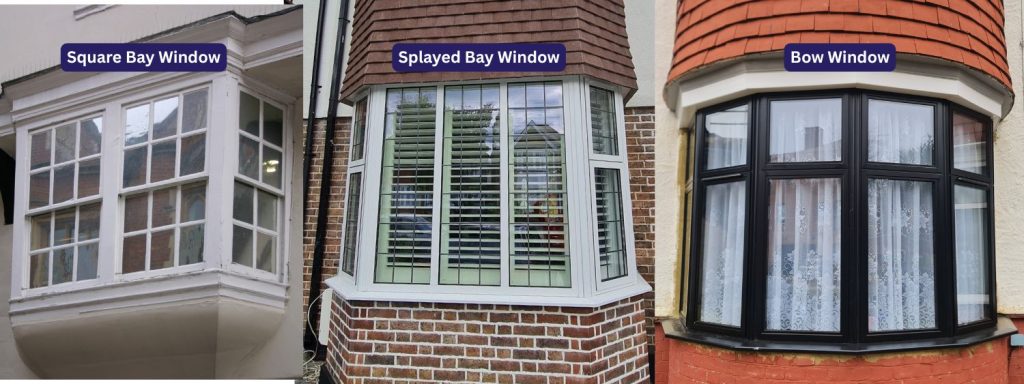Have you ever wished that your living room felt brighter, more spacious, and architecturally stunning—without undergoing a major renovation? Splayed bay windows could be the answer. Whether you’re a homeowner looking to renovate your home or a professional involved in new construction project, this comprehensive guide will help you make the most of splayed bay windows. It covers everything from design inspiration to technical know-how.
What is Splayed bay window?
A splayed bay window is a type of bay window commonly found in Victorian properties in the UK. It is made of 3 sections of windows. It often features a central large window section along with smaller side panels that are angled or “splayed” outwards. This design creates a trapezoidal shape, allowing for more light and space inside the room. Splayed Bay Windows also known as Canted bay windows.
Splayed bay windows originated in medieval architecture, typically seen in castles and manor houses. They were designed to offer wider views and allow more light into rooms. Over time, this design evolved and became popular in Victorian and Edwardian homes, valued for both its aesthetic appeal and practical benefits.
How Splay Bay Window is Different from Other Bay Windows Types?
There are four types of bay windows commonly seen in UK homes: Splay Bay, Square Bay, Single-End, and Bow Windows. While all bay window structures extend outward from the main external wall, the main difference lies in their structural shape. Square bay windows and splay bay windows both consist of a main middle casement window section and two side sections of windows. In square bay windows, the side windows are positioned at a 90-degree angle to the main middle section, creating a rectangular or square shape. In contrast, splayed bay windows have side panels that are angled outward (more than 90 degrees), resulting in a trapezoidal shape. Bow windows consist of four or more windows that create a gentle curve, resulting in a more rounded appearance. Single-End bay windows have one side panel instead of two.

| Feature | Splayed Bay Window | Square Bay Window | Bow Window |
|---|---|---|---|
| Side Panel Angles | Angled outward (trapezoidal) | Perpendicular (rectangular) | Multiple panels, gentle curve |
| Appearance | Dynamic, contemporary or classic | Traditional, boxy | Elegant, rounded |
| View & Light | Wide, panoramic | Focused, less expansive | Sweeping, curved |
What are the Benefits of Splayed Bay Windows?
Aesthetic Appeal: They enhance architectural interest and add elegance to a property, creating a more dynamic and visually appealing façade both inside and out.
Internal Space: Outward side window shape create additional space inside the house. That can be used for various purpose such as seating, storage and display.
Increase Natural Light: The angled design allows sunlight to enter the room from multiple directions, brightening the interior space and reducing the need for artificial lighting.
Improved Ventilation: Openable side windows, positioned at an angle, enhance airflow and ventilation in the room.
How much Splayed Bay Windows Cost You?
The cost to Supply and install splayed bay window typically ranges from £900 to £3,000, depending on factors such as size, materials, and labor costs.
Consult with Durajoin team to get free precious cost of supply only and with installation of bay windows free! : Get Free Quote
What Material are best for splay windows?
Splayed bay windows are made from a variety of materials, each offering specific advantages:
Wood: Provides a classic and warm appearance while delivering good insulation. However, it requires regular maintenance.
uPVC: A low-maintenance and cost-effective option with strong insulation properties. It is available in different styles and colors.
Aluminium: Known for its strength and durability, aluminium bay windows frames are often slim, which maximizes the glass surface area. They also require minimal maintenance.
FAQ:
How do you measure for a splayed bay window?
To measure a splayed bay window, you will need to take several measurements:
1. Measure the width of the window at the front.
2. Measure the depth from the front of the window to the back wall.
3. Measure the angles of the splay.
4. Finally, measure the height from the top to the bottom of the window frame.
Make sure to record these measurements accurately for the best results.What are the energy efficiency benefits of splayed bay windows?
Splayed bay windows can improve energy efficiency by increasing natural light in a room, reducing the reliance on artificial lighting, and offering enhanced insulation thanks to their design, which aids in maintaining indoor temperatures more effectively.
How do you clean and maintain a splayed bay window?
To clean and maintain a splayed bay window, regularly dust and wipe down the window frames and glass using a mild detergent solution. Be sure to pay special attention to the corners and crevices. Additionally, check for any signs of damage or wear, such as cracked seals or peeling paint. Address these issues promptly to prevent further deterioration.
Can splayed bay windows be used in modern home designs?
Yes, splayed bay windows can be incorporated into modern home designs, providing both aesthetic appeal and functional benefits such as increased natural light and improved views, making them a versatile choice for contemporary architecture.
Do you require planning permission to install splayed bay windows?
If you are replacing an existing splayed bay window, you do not need planning permission. However, if you are adding new splay bay windows to the front of the house, you will need planning permission. Generally, adding new bay windows to the side or back of the house does not require planning permission.
Read our detail guide on planning permission for bay windows.


